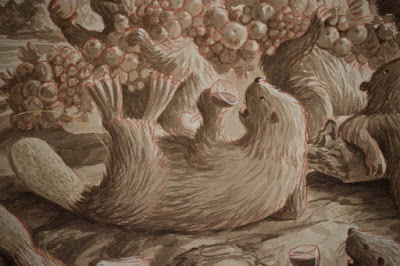Kent Monkman, popular Canadian First Nations artist, has created a powerful and gut-wrenching exhibition at the University of Toronto Art Centre. The show is Monkman's contribution to the national celebration of the 150th anniversary of Canadian Confederation.
We first meet Monkman's two-spirit, alter-ego, Miss Chief Eagle Testickle, as a newborn in a diorama creche-scene.
The paintings in the exhibition are lit to bring out their "diorama" quality.
In Le Petit Déjeuner sur l'herbe, 2014, wounded Native people are painted in a Picasso-esque Cubist style while naturalistic angels hover overhead.
Here in Bad Medicine, 2014, grizzly bears confront European angels over the remains of a Native woman who is painted in the style of Francis Bacon.
In this detail from Bad Medicine, warriors emerge out of the foliage.
In Seeing Red, 2014, Miss Chief confronts a bison bull in a raw suburban setting. Monkman often mixes his serious concerns with humour to make his points.
In another room Native children are torn from their parents by priests and Mounties to be "retrained" in residential schools in The Scream, 2016.
A detail from
The Scream. Monkman quotes Duncan Campbell Scott's chilling words written in 1910, when he was head of the Department of Indian Affairs: "...Indian children...die at a much higher rate than in their villages. But this alone does not justify a change in the policy of this Department, which is being geared towards the final solution of our Indian problem."
Here I'm photographing the label for
Reincarceration, 2013. Monkman's paintings often draw on Victorian landscape traditions such as we might find in Albert Bierstadt and Thomas Cole.
Iron Horse, 2015, is another example of this borrowing, and a clever pun.
The railroads proved to be a Trojan Horse, bringing disaster to the original inhabitants of the prairies.
In the diorama
Scent of a Beaver, 2016, Miss Chief Eagle Testickle, perhaps representing the spirit of Canada, is seen swinging between representatives of the French and British Empires.
We liked seeing Monkman's work installed with historical works.
Here Benjamin West's
The Death of General Wolfe, c. 1760, has never looked more flamboyant.
Did The Fruit Dance, c 1616-1617 (from the Studio of Peter Paul Rubens)
inspire Monkman's vision of bucolic beaver in their natural state
Study for the Beaver Bacchanal, 2015 (with detail).
On the left find The Massacre of the Innocents, 2015,
with its stuffed-toy-like beaver being slaughtered by white hunters.
Robert Harris' Prepatory Drawing for the Fathers of Confederation, 1883.
Monkman's version of The Fathers of Confederation, renamed The Daddies, 2016, in which Miss Chief confronts Canada's founding fathers.
We'll leave you with The Bears of Confederation, 2016. Pardon us for not showing you details of the action but this is one painting you are going to have to see for yourself.
We exited the art gallery with a deeply enriched concept of the Federation that Canada is presently celebrating. Shame and Prejudice: A Story of Resilience is not to be missed. Until March 4th.


































